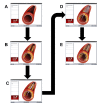Medical student appraisal: applications for bedside patient education
- PMID: 23874358
- PMCID: PMC3716424
- DOI: 10.4338/ACI-2013-01-R-0007
Medical student appraisal: applications for bedside patient education
Abstract
Background: Medical students are often afforded the privilege of counselling patients. In the past resources were limited to pen and paper or anatomic models. The evolution of mobile applications allows for limitless access to resources that facilitate bedside patient education.
Objectives: To evaluate the utility of six applications in patient education and promote awareness of implementing mobile resources in clinical care.
Methods: Six medical students rotating on various clerkships evaluated a total of six mobile applications. Strengths, limitations, and suggested uses in clinical care were identified. Applications included Meditoons™, VisiblePatient™, DrawMD™, CardioTeach™, Visual Anatomy™, and 360° Patient Education Suite™. Data was generated from narrative responses supplied by each student during their evaluation period.
Results: Bedside teaching was enhanced by professional illustrations and animations depicting anatomy and pathophysiology. Impromptu teaching was facilitated, as resources were conveniently available on a student's smartphone or tablet. The ability to annotate and modify images and subsequently email to patients was an extraordinary improvement in provider-patient communication. Universal limitations included small smartphone screens and the novelty of new technology.
Discussion: Mobile applications have the potential to greatly enhance patient education and simultaneously build rapport. Endless opportunities exist for their integration in clinical practice, particularly for new diagnoses, consent for procedures, and at time of discharge. Providers should be encouraged to try new applications and utilize them with patients.
Keywords: Application; electronics; mobile health; patient education; smartphone.
Figures
References
-
- Greene JA. Releasing the Flood Waters: Diuril and the Reshaping of Hypertension. Bull Hist Med 2005; 79: 749-794 DOI: dx.doi.org/10.1353/bhm.2005.0153 - PubMed
-
- Miller KH, Ziegler C, Greenberg R, Patel PD, Carter MB. Why physicians should share PDA/smartphone findings with their patients: A brief report. J Health Commun 2012; 17: 54-61 DOI: dx.doi.org/10.1080/10810730.2011.649102 - PubMed
-
- Ozdalga E, Ozdalga A, Ahuja N. The smartphone in medicine: A review of current and potential use among physicians and students. J Med Internet Res 2012; 14 DOI: dx.doi.org/10.2196/jmir.1994 - PMC - PubMed
-
- Pearlswan Communications LLC. Meditoons, version 2.0. 2012. AccessedJanuary 3, 2013. Available at: http://www.meditoons.com
-
- Research Institute against Digestive Cancer (IRCAD). The Visible Patient, version 0.3. 2010. AccessedJanuary 3, 2013. Available at:http://visiblepatient.eu
Publication types
MeSH terms
LinkOut - more resources
Full Text Sources
Other Literature Sources
Miscellaneous


